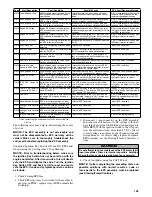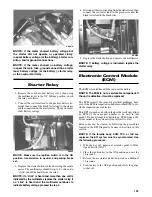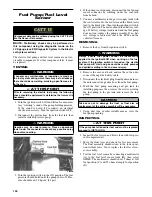
142
Taillight-Brakelight
VOLTAGE (Taillight)
NOTE: Perform this test at the socket end of the
taillight-brakelight harness (pigtail). The ignition
switch must be in the ON position and either high
beam or low beam selected on the light switch.
1. Set the meter selector to the DC Voltage position.
2. Connect the black tester lead to the black wire; then
connect the red tester lead to the white wire. The
meter should show battery voltage.
3. With the ignition key in the LIGHTS position, the
meter must show battery voltage.
NOTE: If battery voltage is not shown and the
headlights are illuminated, inspect the three-wire
connector in the left-rear canopy tube at the junc-
ture of the canopy tube and lower frame. If battery
voltage is shown on the meter, replace the bulb.
VOLTAGE (Brakelight)
NOTE: Perform this test at the socket end of the
taillight-brakelight harness (pigtail). The ignition
switch must be in the ON position.
1. Set the meter selector to the DC Voltage position.
2. Connect the red tester lead to the red/blue wire; then
connect the black tester lead to the black wire.
3. With the brake applied, the meter must show battery
voltage.
NOTE: If the meter shows no voltage, inspect the
10 amp ignition (IGN) fuse, brakelight switch, wir-
ing harness, or connectors.
Ignition Timing
The ignition timing cannot be adjusted; however, verifying
ignition timing can aid in troubleshooting other components.
To verify ignition timing, use the following procedure.
NOTE: To check ignition timing, the seat, seat
back, and seat base must be removed.
1. Attach the Timing Light to the spark plug high ten-
sion lead; then remove the timing inspection plug
from the left-side crankcase cover.
2. Start the engine and using the RPM function on the
speedometer/tachometer, run at 1500 RPM; ignition
timing should be 10° BTDC.
3. Install the timing inspection plug.
If ignition timing cannot be verified, the rotor may be dam-
aged, the key may be sheared, the trigger coil bracket may
be bent or damaged, or the ECM may be faulty.
Tilt Sensor
SUPPLY VOLTAGE
1. Disconnect the three-wire connector from the sensor;
then select DC Voltage on the multimeter and con-
nect the red tester lead to the orange wire (C) and the
black tester lead to the black wire (A).
CD706A
2. Turn the ignition switch to the ON position. The
multimeter should read battery voltage. If battery
voltage is not indicated, check the 30-amp fuse in the
PDM or the 10-amp ignition fuse, wiring harness, or
the ignition switch.
3. Remove the red tester lead and connect to the pin B.
The multimeter should read approximately 2.5 DC
volts (700) or 0.5 DC volts (500). If the specified
voltage is not indicated, check wire connections at
the ECM or substitute another ECM to verify the
test.
CD706B
! WARNING
Incorrect installation of the tilt sensor could cause sud-
den loss of engine power which could result in loss of
vehicle control resulting in injury or death.
CAUTION
Do not drop the tilt sensor as shock can damage the
internal mechanism.
Содержание PROWLER HDX 2015
Страница 3: ......
Страница 191: ...188 NOTES...
Страница 192: ...Printed in U S A Trademarks of Arctic Cat Inc Thief River Falls MN 56701 p n 2260 410...















































